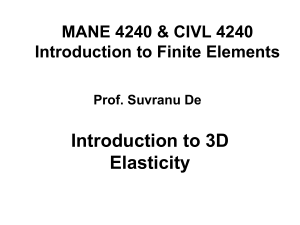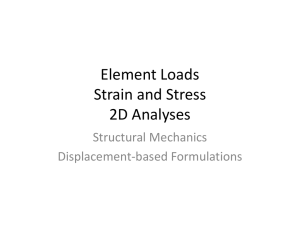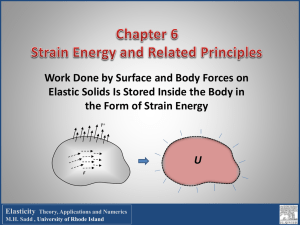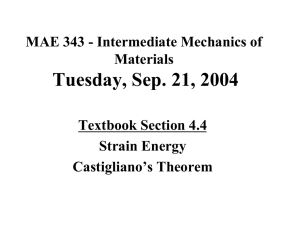Deformation and Strain
advertisement
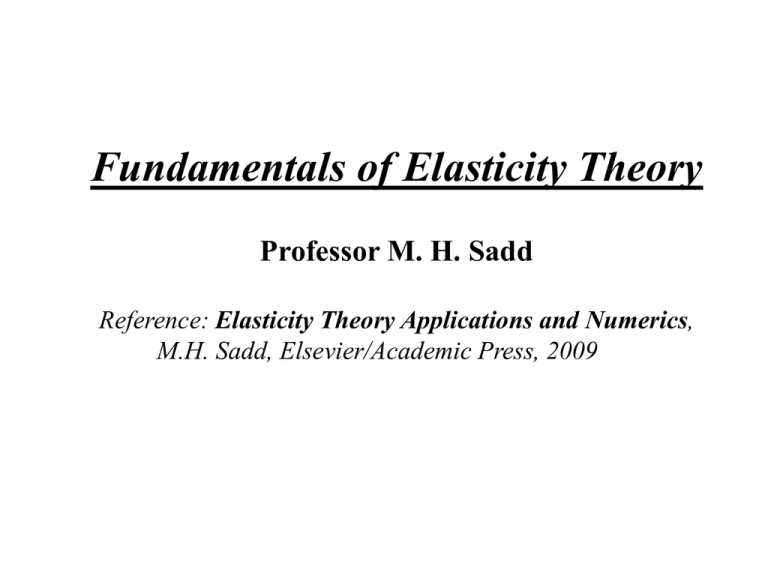
Fundamentals of Elasticity Theory
Professor M. H. Sadd
Reference: Elasticity Theory Applications and Numerics,
M.H. Sadd, Elsevier/Academic Press, 2009
Theory of Elasticity
Based Upon Principles of Continuum Mechanics, Elasticity Theory Formulates
Stress Analysis Problem As Mathematical Boundary-Value Problem for
Solution of Stress, Strain and Displacement Distribution in an Elastic Body.
St
Boundary Conditions Describe
Physics on Boundary
(Different For Each Problem)
Su
R
Governing Field Equations
Model Physics Inside Region
(Same For All Problems)
Value of Elasticity Theory
- Develops “Exact” Analytical Solutions For Problems of Limited Complexity
- Provides Framework for Understanding Limitations of Strength of Materials Models
- Establishes Framework for Developing Linear Finite Element Modeling
- Generates Solutions for Benchmark Comparisons with FEA Solutions
Deformation and Strain
Two-Dimensional Theory
u
dy
y
D'
Strain Displacement Relations
C'
v(x,y+dy)
y
D
C
B'
A'
v
dx
x
dy
v(x,y)
A
u
x
v
ey
y
ex
dx
B
u(x+dx,y)
1 u v 1
exy xy
2 y x 2
u(x,y)
x
Three-Dimensional Theory
ex
e [e] e yx
ezx
exy
ey
ezy
exz
e yz
ez
Deformation and Strain Example
Determinethecomponentsof strain for thefollowingdisplacement field
u Axz , v B( x 2 y 2 ) , w Cxy , where A, B, C are const ants
__________
__________
__________
__________
_
u
ex
Az
x
v
ey
2 By
y
w
ez
0
z
1 u v 1
exy 0 2 Bx Bx
2 y x 2
1 v w 1
1
0 Cx Cx
e yz
2 z y 2
2
1 w u 1
ezx
Cy Ax
2 x z 2
Rigid Body Motion
Two-Dimensional Example
z
u
y
D
C
y
dy
z
vo
A
dx
v
x
B
uo
x
General Form of Displacement Field
u* uo z y
v* vo z x
Zero Strains!
Strain Compatibility
1
2
3
4
y
x
Discretized Elastic Solid
Undeformed Configuration
1
2
1
3
4
3
Deformed Configuration
Continuous Displacements
Compatibility Equation
2
4
Deformed Configuration
Discontinuous Displacements
2
2exy
2ex ey
2
y 2 x 2
xy
Strain Compatibility Example
Check tosee if thefollowingstrain field
ex Ay3 , e y Ax3 , exy Bxy( x y )
satisfies the two - dimensional compatibility equation
__________
__________
__________
__________
__
2
2 exy
2 ex e y
2 2
6 Ay 6 Ax 2 B(2 x 2 y )
2
y
x
xy
2
6 A 4B A B
3
2
onlysatisfiesequation with A B
3
Body and Surface Forces
Body Forces: F(x)
Surface Forces: T(x)
Cantilever Beam Under Self-Weight Loading
S
Sectioned Axially Loaded Beam
Traction and Stress
P3
P2
F
n
A
p
P1
(Sectioned Body)
(Externally Loaded Body)
Traction Vector
F
A0 A
T n ( x, n) lim
Note that ordinary elasticity theory does not include nor allow
concentrated moments to exist at a continuum point
Stress Components
y
T n ( x, n e1 ) x e1 xye2 xze3
yx
yz
xy
zy
y
zx
z
x
z
T n ( x, n e2 ) yxe1 y e2 yze3
xz
x
T n ( x, n e3 ) zx e1 zy e2 z e3
x
[ ] yx
zx
xy
y
zy
xz
yz
z
T n (σ x nx τ yx n y τ zx nz )e1
( τ xy nx σ y n y τ zy nz )e 2
( τ xz nx τ yz n y σ z nz )e 3
Stress Transformation
x3
Three-Dimensional Transformation
x3
x x l12 y m12 z n12 2( xy l1m1 yz m1n1 zx n1l1 )
x2
e3
e3
x2
e1
x1
z x l32 y m32 z n32 2( xy l3m3 yz m3n3 zx n3l3 )
xy x l1l2 y m1m2 z n1n2 xy (l1m2 m1l2 ) yz (m1n2 n1m2 ) zx (n1l2 l1n2 )
e2
e2
e1
y x l22 y m22 z n22 2( xy l2 m2 yz m2 n2 zx n2 l2 )
x1
l1
cos(xi, x j ) l2
l3
m1
m2
m3
yz x l2 l3 y m2 m3 z n2 n3 xy (l2 m3 m2 l3 ) yz (m2 n3 n2 m3 ) zx (n2 l3 l2 n3 )
zx x l3l1 y m3m1 z n3n1 xy (l3m1 m3l1 ) yz (m3n1 n3m1 ) zx (n3l1 l3n1 )
n1
n2
n3
y
y'
Two-Dimensional Transformation
x x cos2 y sin 2 2 xy sin cos
x'
y x sin 2 y cos2 2 xy sin cos
xy x sin cos y sin cos xy (cos2 sin 2 )
x
Stress Transformation Example
x
x
u
x cos 2
x sin cos
Dimensionless Stress
1
/ x cos2
0.5
0
/ x sin cos
-0.5
0
10
20
30
40
50
(degrees)
60
70
80
90
Principal Stresses and Directions
( x )
xy
xz n1
xy n1 ( y )n2 yz n3 0 xy
( y )
yz n2 0
xz
xz n1 yz n2 ( z )n3 0
yz
( z ) n3
( x )n1 xy n2 xz n2 0
Homogeneous System of Algebraic Equations,Non - T rivalSolution
( x )
xy
xz
xy
( y )
yz
xz
yz
( z )
0 3 I12 I 2 I 3 0
Ii = Fundamental
Invariants
Roots of the characteristic equation are the principal stresses 1 2 3
Corresponding to each principal stress is a principal direction n1 n2 n3
that can be used to construct a principal coordinate system
y
2
yx
yz
zx
xz
z
x
z (General Coordinate System)
1
n2
xy
zy
y
2
n1
x
3
n3
3
(Principal Coordinate System)
1
Equilibrium Equations
y
y
y
dy
yx
Fy
x
y
dy
xy
Fx
xy
Body Forces
yx
xy
x
x
dx
x
dx
x
yx
y
x yx
Fx 0
x
y
xy y
F
0
Fy 0
y
x
y
Fx 0
M 0
xy yx
Equilibrium Equation Example
Assuming no body forces,show t hat t hefollowing
st ressessat isfy t he equilibrium equat ions
3Pxy N
3P
y2
x
, y 0 , xy
(1 2 )
3
2c
2c
4c
c
__________
__________
__________
_________
x yx
3Py 3Py
0 3 3 0 a
x
y
2c
2c
xy y
0 00 0 a
x
y
Hooke’s Law
x C11e x C12 e y C13 e z 2C14 e xy 2C15 e yz 2C16 e zx
y C 21e x C 22 e y C 23 e z 2C 24 e xy 2C 25 e yz 2C 26 e zx
z C31e x C32 e y C33 e z 2C34 e xy 2C35 e yz 2C36 e zx
xy C 41e x C 42 e y C 43 e z 2C 44 e xy 2C 45 e yz 2C 46 e zx
yz C51e x C52 e y C53 e z 2C54 e xy 2C55 e yz 2C56 e zx
zx C61e x C62 e y C63 e z 2C64 e xy 2C65 e yz 2C66 e zx
Isotropic Homogeneous Materials
x ( e x e y e z ) 2e x
y ( e x e y e z ) 2e y
z ( e x e y e z ) 2e z
xy 2e xy
yz 2e yz
zx 2e zx
= Lamé’s constant
= shear modulus or modulus of rigidity
E = modulus of elasticity or Young’s modulus
v = Poisson’s ratio
1
x ( y z )
E
1
e y y ( z x )
E
1
e z z ( x y )
E
1
1
e xy
xy
xy
E
2
1
1
e yz
yz
yz
E
2
1
1
e zx
zx
zx
E
2
ex
Orthotropic Materials
(Three Planes of Material Symmetry)
x
y
z
yz
zx
xy
1
E
1
12
E1
13
E1
21
E2
1
E2
23
E2
31
E3
32
E3
1
E3
0
0
0
0
0
0
1
23
0
1
31
0
0 ex
ey
0
ez
2e yz
0
2e zx
2
e
0 xy
1
12
Nine Independent Elastic Constants for 3-D
Four Independent Elastic Constants for 2-D
Physical Meaning of Elastic Constants
p
p
p
(Hydrostatic Compression)
0
p 0
ij 0 p 0 p ij
0 p
0
(Simple Tension)
E
0 0
ij 0 0 0 eij 0
0 0 0
0
E / ex
0
0
E
0
E
0
(Pure Shear)
0 0
ij 0 0
0 0 0
/ 2 0
0
eij / 2
0
0
0
0
0
/ 2exy / xy
1 2
0
0
E p
1 2
eij
0
p
0
E
1 2
0
0
E
p
3(1 2)
p p k
E
E
p
k
Bulk Modulus
3(1 2)
ekk
Relations Among Elastic Constants
Typical Values of Elastic Constants
Basic Formulation
Fundamental Equations (15)
- Strain-Displacement (6)
- Compatibility (3)
- Equilibrium (3)
- Hooke’s Law (6)
Fundamental Unknowns (15)
- Displacements (3)
- Strains (6)
- Stresses (6)
Typical Boundary Condtions
T(n)
S
S
R
St
R
Su
R
u
Traction Conditions
Displacement Conditions
Mixed Conditions
Basic Problem Formulations
Problem 1 (Traction Problem) Determine the distribution of displacements, strains and stresses in
the interior of an elastic body in equilibrium when body forces are given and the distribution of the
tractions are prescribed over the surface of the body.
Problem 2 (Displacement Problem) Determine the distribution of displacements, strains and stresses
in the interior of an elastic body in equilibrium when body forces are given and the distribution of the
displacements are prescribed over the surface of the body.
Problem 3 (Mixed Problem) Determine the distribution of displacements, strains and stresses in the
interior of an elastic body in equilibrium when body forces are given and the distribution of the
tractions are prescribed over the surface St and the distribution of the displacements are prescribed
over the surface Su of the body.
T(n)
S
S
R
St
R
Su
R
u
Traction Conditions
Displacement Conditions
Mixed Conditions
Basic Boundary Conditions
Coordinate Boundary Examples
r
y=Ty
xy=Tx
r
x
r
r
y
xy=Ty
r
x=Tx
y
x
(Cartesian Coordinate Boundaries)
(Polar Coordinate Boundaries)
Non-Coordinate Boundary Example
n = unit normal vector
Ty( n) xynx y ny Fy ( x, y)
Tx(n) x nx xyny Fx ( x, y)
y
x
Boundary Condition Examples
Fixed Condition Traction Condition
Tx( n ) x S, Ty( n ) xy 0
u=v=0
y
(n)
x
T
Traction Condition
xy 0, Ty( n ) y S
S
x
b
l
S
Tx( n) 0
Ty( n) 0
a
x
Traction Free Condition
Tx( n ) xy 0, Ty( n ) y 0
(Coordinate Surface Boundaries)
y
Fixed Condition
u=v=0
Traction Free Condition
(Non-Coordinate Surface Boundary)
Symmetry Boundary Conditions
Rigid-Smooth
Boundary Condition
Symmetry Line
u0
Ty( n ) 0
y
x
Example Solution – Beam Problem
x
x - Contours
Saint-Venant’s Principle
The Stress, Strain and Displacement Fields Due to Two Different Statically
Equivalent Force Distributions on Parts of the Body Far Away From the Loading
Points Are Approximately the Same.
P/2
P/2
P
x
x
y
y
xy
xy
x
x
y
y
Stresses Approximately Equal
Strain Energy
Strain Energy = Energy Stored Inside an
Elastic Solid Due to the Applied Loadings
One-Dimensional Case
u
y
dy
dz
dx
u
x
x
u
dx)dydz dudydz
0
0
x
x
x
u
d
d ( )dxdydz dxdydz
0
0
x
E
2x
dxdydz
2E
2x Eex2 1
Strain Energy
dU
U
x ex
Volume
dxdydz 2 E
2
2
x
u
dx
x
dU d (u
z
Three-Dimensional Case
1
1
( x ex y e y z ez xy xy yz yz zx zx ) ij eij
2
2
1
1
1
1
(ex e y ez ) 2 (ex2 e y2 ez2 2xy 2yz 2zx ) 0
2
2
2
2
U
Principle of Virtual Work
The virtual displacement ui = {u, v, w} of a material point is a fictitious
displacement such that the forces acting on the point remain unchanged. The work
done by these forces during the virtual displacement is called the virtual work.
U T Virtual Strain Energy ij eij dV
V
( x ex y e y z ez xy xy yz yz zx zx )dV
V
W Virtual Work Done by Surface and Body Forces
Ti n ui dS Fi ui dV
St
V
Virtual Strain Energy = Virtual Work Done by Surface and Body Forces
V
ijeij dV Ti n ui dS Fi ui dV
St
V
Change in Potential Energy (UT-W) During a
Virtual Displacement from Equilibrium is Zero.
U dV Ti n ui dS Fi ui dV U T W 0
St
V
V



